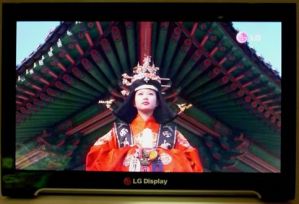LG has developed a new 15" WOLED display. In this display, RGB is achieved by using a white AMOLED pixel with a color filter. The resolution is 1366x768, the brightness is 200 nits (peak:450nits), color gamut 100% and the contrast is 100,000:1.

Comments
I agrree with the opinion about energy (or efficiency) waste whene using color filter.
But in my knowledge, there may be some advantages using WOLED & color filter.
The most important thing may be ease of fabrication process for large-area.
Because fine patterning of sub-pixels by thin metal mask becomes difficult by increasing substrate area.
So without patterning organic emiting materials, the production yield can be imporved, I think.
Anyway, the ultimate goal is, of course, achieving RGB-pixeled large area OLEDs. :)
There have been several papers in which the authors describe the difficulty of generating an efficient red emitting molecule. To produce a display, one not only wants red, green and blue emitting materials, but efficient (ie light out vs. power in) materials.
If the red is not "red" (ie CIE color) or if it doesn't age similarly to the blue and green emitters it won't be as desirable (the red dies and you are left with a screen that is no longer full color). Also, if the red pixel must be addressed differently from the blue and green pixel it will complicated the device geometry and increase the cost.
I have also read several papers that cite efficient red emitting materials, and I would venture a guess that these materials will be replacing the white-LED/filter approach.


Is this color generation method common among OLED screens? I think it wastes energy generating light that will be blocked by the filter. Isn't it possible to create subpixels via specific materials that only generate their component color and don't need color filters? (i.e. a red subpixel which emits only red, etc.)